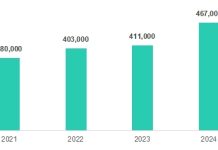
With prolonged global trade disruptions accelerating the demand for digital services to strengthen supply chains, DBS is intensifying its efforts to digitalise financing capabilities offered through trade platforms, potentially benefiting more than 15,000 SMEs across Asia by end of 2022.
According to the DBS Digital Readiness Survey, 97% of businesses in Asia-Pacific have indicated that they are facing external pressure to transform digitally, citing growing supply chain complexities as one of the push factors for change. However, the speed of change in the surrounding macro and business environment, coupled with the high costs of adopting new technologies, remain often cited hurdles to digitalisation.
To support businesses in adapting to the evolving landscape characterised by prolonged trade disruptions and geopolitical tensions, DBS is set to launch five new platform partnerships in 2022, it said in a statement.
These platforms will have integrated digital and supply chain financing capabilities which are expected to benefit SMEs across Singapore, Hong Kong, China, India and Indonesia by the end of this year.
Sectors that will benefit from the launch of the upcoming digital platforms include e-commerce, logistics and commodities, among others. Since 2017, DBS has launched 12 digital platform partnerships with integrated digital financing and payments capabilities.
DBS currently partners with large and established anchors in multiple sectors including technology, media and telecom, apparel, consumer products, food & agriculture, automotive and logistics, to provide competitive digital financing options to their network of suppliers and/or distributors through digital trade platforms. In 2021, DBS onboarded 45 new anchors and more than 5,000 suppliers and distributors through digital platforms.
In a testament to the relevance of DBS’ digital financing solutions, more than nine in 10 of the bank’s supply chain finance transactions across Asia were carried out through digital platforms last year.
These efforts translated to DBS registering robust growth in revenue from trade ecosystems which doubled year on year in 2021.
Additional digitally enabled capabilities such as intuitive lending, cash management and trade finance services, as well as foreign exchange solutions also enable the bank to provide its corporate clients a more customised and seamless experience.
Raof Latiff, group head of ecosystems, DBS, said: “Corporates across all sectors and scales are feeling rising pressure to keep pace with the latest digital developments while navigating ongoing global supply chain disruption and economic headwinds.
“To help relieve some of this burden, we continue to leverage our extensive suite of digital solutions to deliver integrated financing solutions that can help businesses overcome challenges and further fortify their business resilience.”
These collective efforts are in line with the bank’s strategy to further catalyse the development and adoption of digital trade platforms and embedded digital financing solutions across industries to bolster the resilience of supply chains.
“Corporates across all sectors and scales are feeling rising pressure to keep pace with the latest digital developments while navigating ongoing global supply chain disruption and economic headwinds,” Raof added.
Almost all or 97% of businesses in Asia-Pacific have indicated that they are facing external pressure to transform digitally, with growing supply chain complexities as one of the push factors for change, according to the DBS Digital Readiness Survey. However, they face hurdles in the speed of change in the surrounding macro and business environment as well as the high costs of adopting new technologies.
Wei Li-Tuomela, vice president, Stora Enso Oyj, a global provider of renewable solutions headquartered in Finland, said, “Through the pandemic years, DBS took the initiative to accelerate the implementation of digital financing lines for our suppliers. The speed at which financing can be offered to our suppliers and the ease of being onboarded digitally from end-to-end has also helped smooth out the challenges during the height of trade disruptions.”














